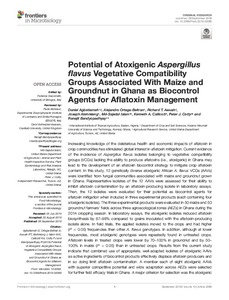| dc.contributor.author | Agbetiameh, D. |
| dc.contributor.author | Ortega-Beltran, A. |
| dc.contributor.author | Awuah, R.T. |
| dc.contributor.author | Atehnkeng, J. |
| dc.contributor.author | Islam, M.S. |
| dc.contributor.author | Callicott, K.A. |
| dc.contributor.author | Cotty, P.J. |
| dc.contributor.author | Bandyopadhyay, R. |
| dc.date.accessioned | 2019-12-04T11:36:48Z |
| dc.date.available | 2019-12-04T11:36:48Z |
| dc.date.issued | 2019 |
| dc.identifier.citation | Agbetiameh, D., Ortega-Beltran, A., Awuah, R.T., Atehnkeng, J., Islam, M.S., Callicott, K.A., ... & Bandyopadhyay, R. (2019). Potential of atoxigenic Aspergillus flavus vegetative compatibility groups associated with maize and groundnut in Ghana as biocontrol agents for aflatoxin management. Frontiers in Microbiology, 10, 1-15. |
| dc.identifier.issn | 1664-302X |
| dc.identifier.uri | https://hdl.handle.net/20.500.12478/6352 |
| dc.description | Open Access Journal; Published online: 06 Sept 2019 |
| dc.description.abstract | Increasing knowledge of the deleterious health and economic impacts of aflatoxin in crop commodities has stimulated global interest in aflatoxin mitigation. Current evidence of the incidence of Aspergillus flavus isolates belonging to vegetative compatibility groups (VCGs) lacking the ability to produce aflatoxins (i.e., atoxigenic) in Ghana may lead to the development of an aflatoxin biocontrol strategy to mitigate crop aflatoxin content. In this study, 12 genetically diverse atoxigenic African A. flavus VCGs (AAVs) were identified from fungal communities associated with maize and groundnut grown in Ghana. Representative isolates of the 12 AAVs were assessed for their ability to inhibit aflatoxin contamination by an aflatoxin-producing isolate in laboratory assays. Then, the 12 isolates were evaluated for their potential as biocontrol agents for aflatoxin mitigation when included in three experimental products (each containing four atoxigenic isolates). The three experimental products were evaluated in 50 maize and 50 groundnut farmers’ fields across three agroecological zones (AEZs) in Ghana during the 2014 cropping season. In laboratory assays, the atoxigenic isolates reduced aflatoxin biosynthesis by 87–98% compared to grains inoculated with the aflatoxin-producing isolate alone. In field trials, the applied isolates moved to the crops and had higher (P < 0.05) frequencies than other A. flavus genotypes. In addition, although at lower frequencies, most atoxigenic genotypes were repeatedly found in untreated crops. Aflatoxin levels in treated crops were lower by 70–100% in groundnut and by 50–100% in maize (P < 0.05) than in untreated crops. Results from the current study indicate that combined use of appropriate, well-adapted isolates of atoxigenic AAVs as active ingredients of biocontrol products effectively displace aflatoxin producers and in so doing limit aflatoxin contamination. A member each of eight atoxigenic AAVs with superior competitive potential and wide adaptation across AEZs were selected for further field efficacy trials in Ghana. A major criterion for selection was the atoxigenic isolate’s ability to colonize soils and grains after release in crop field soils. Use of isolates belonging to atoxigenic AAVs in biocontrol management strategies has the potential to improve food safety, productivity, and income opportunities for smallholder farmers in Ghana. |
| dc.description.sponsorship | Bill & Melinda Gates Foundation |
| dc.format.extent | 1-15 |
| dc.language.iso | en |
| dc.rights | CC-BY-4.0 |
| dc.subject | Aflatoxins |
| dc.subject | Biological Control |
| dc.subject | Foods |
| dc.subject | Maize |
| dc.subject | Groundnuts |
| dc.subject | Ghana |
| dc.title | Potential of atoxigenic Aspergillus flavus vegetative compatibility groups associated with maize and groundnut in Ghana as biocontrol agents for aflatoxin management |
| dc.type | Journal Article |
| dc.description.version | Peer Review |
| cg.contributor.crp | Agriculture for Nutrition and Health |
| cg.contributor.crp | Maize |
| cg.contributor.affiliation | International Institute of Tropical Agriculture |
| cg.contributor.affiliation | Kwame Nkrumah University of Science and Technology |
| cg.contributor.affiliation | United States Department of Agriculture |
| cg.coverage.region | Africa |
| cg.coverage.region | West Africa |
| cg.coverage.country | Ghana |
| cg.creator.identifier | Alejandro Ortega-Beltran: 0000-0003-3747-8094 |
| cg.creator.identifier | Ranajit Bandyopadhyay: 0000-0003-2422-4298 |
| cg.researchtheme | PLANT PRODUCTION & HEALTH |
| cg.isijournal | ISI Journal |
| cg.authorship.types | CGIAR and developing country institute |
| cg.iitasubject | Aflatoxin |
| cg.iitasubject | Disease Control |
| cg.iitasubject | Food Security |
| cg.iitasubject | Maize |
| cg.iitasubject | Plant Diseases |
| cg.journal | Frontiers in Microbiology |
| cg.howpublished | Formally Published |
| cg.accessibilitystatus | Open Access |
| local.dspaceid | 107860 |
| cg.targetaudience | Scientists |
| cg.identifier.doi | https://dx.doi.org/10.3389/fmicb.2019.02069 |

